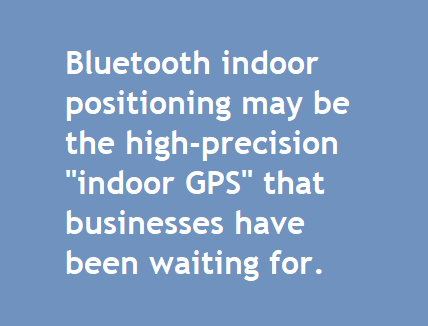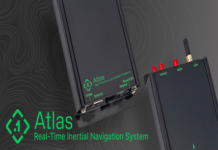
Bluetooth indoor positioning may be the high precision “indoor GPS” that businesses have been waiting for.
For many businesses operating under an open sky, the arrival of GPS came as a godsend. With it, first vehicles, later people, could always know their precise location. The Internet of things brought a new wave of innovation, making these positions visible in real-time to those authorized via cloud-hosted platforms. Suddenly, logistics companies could locate their shipments, fleet managers their vehicles, maintenance operators their staff, and farmers their livestock. Decades after the introduction of GPS and the IoT, industrial adoption of real-time location systems (RTLS) is still gaining momentum.
For all the economic avenues it has already opened, and the many more that are still in the pipeline, the technology has one blind spot: the great indoors. Global navigation satellite systems rely on signals so weak that, even outdoors under perfect signal conditions, they are drowned out by noise. Near tall buildings, they deteriorate considerably due to shadowing and multipath disturbances. And indoors, they are largely unavailable. This has made indoor positioning with comparable performance to GPS outdoors a gap that companies have been seeking to claim their stake in for years, using a variety of technologies.
Cellular signals, Wi-Fi, Bluetooth, UWB
Cellphone signals, which penetrate deep into buildings, have been used to deliver position estimates indoors and out using a variety of approaches, including cellular network fingerprinting on devices featuring a cellular modem. While a coarse position estimate is often better than none at all, even in the best cases, the achieved accuracy continues to be considerably lower than that of GPS. 5G, with its dense base station networks and high frequency signals, will eventually bring some improvements.
Devices equipped with a Wi-Fi receiver can use Wi-Fi fingerprinting (10-meter accuracy) or time-of-flight methods (1-2 meters accuracy) to locate themselves relative to nearby Wi-Fi hotspots. However, their relatively high power demand and device cost have left IoT device designers wanting.
Bluetooth-equipped devices can use the so-called received signal strength indicator (RSSI) to determine their approximate distance from nearby Bluetooth beacons (5-10 meter accuracy). Its low cost and power consumption as well as the prevalence of Bluetooth on connected devices have contributed to the widespread adoption of Bluetooth RSSI, used in consumer and industrial tracking tags and, most prominently, by COVID-19 contact tracing apps.
Ultra wide band (UWB) technology (0.1-1 meter accuracy) is gaining more and more popularity in high-end mobile phones and other premium smart devices, complementing Bluetooth RSSI to improve the accuracy in lost and stolen asset recovery use cases. Using crowd-sourced location tracking networks pioneered by the likes of Tile, Apple’s FindMy network and the Samsung SmartThings Find service are now taking solutions combining UWB and Bluetooth to their massive global customer bases.
*Approximate figures. The exact values depend on the details of each deployment.
Bluetooth for high precision indoor positioning
The most recent technology to join the fray also builds on Bluetooth, specifically, on a feature included in Bluetooth 5.1: direction finding. Using Bluetooth direction finding, stationary anchor points featuring multi-antenna arrays can determine the angle of arrival (AoA) of a special Bluetooth signal emitted by a mobile tag. When 3 or more anchor points are within line of sight of the tag, the Bluetooth indoor positioning system can triangulate the tag’s position to within one meter.
Key advantages of the Bluetooth direction finding and high precision indoor positioning technology include its low power consumption, the low cost of Bluetooth hardware, the low cost of deployment, as well as the vast existing ecosystem of companies developing Bluetooth-based solutions.
An “indoor GPS” for warehouse automation (and more…)
With its high reliance on location awareness, warehouse automation showcases many of the benefits of Bluetooth indoor positioning solutions. Tagging goods with inexpensive, reusable trackers simplifies stock keeping, locating goods on their shelves, and tracking them in transit. Equipping staff with trackers enables automated access control and process monitoring increasing efficiency. Both use AoA technology, where the position of each tag is calculated and made available on the cloud-based or locally hosted tracking solution.
Finally, robots used in automated warehouses can use real-time location services (RTLS) based on Bluetooth indoor positioning to autonomously shuttle goods from their shelves to where they are needed. This is where the angle-of-departure (AoD)-based Bluetooth indoor positioning technology is used, as it allows the robots to compute their own positions within the warehouse relative to deployed anchor points and access the data with low latency.
The same technologies stand to benefit a wide range of additional use cases. Hospitals will be able to quickly locate tagged medical devices, beds, patients, and staff, saving precious time and resources. In airports, the technology could benefit luggage handling and help keep track of passengers. And in retail, where Bluetooth RSSI is already prevalent, Bluetooth indoor positioning can enable a more personalized shopping experience in exchange for the possibility to track customer’s behavior and send them tailored advertisements.
Getting started with Bluetooth high precision indoor positioning
At u-blox, we’ve been actively testing Bluetooth’s new features, both for direction finding and high precision indoor positioning use cases. In the process, we’ve developed two explorer kits that remove many of the barriers that make the technology challenging to work with. Our u-blox XPLR-AoA-1 explorer kit, which includes one tracker tag and one anchor point as well as the algorithms required to calculate the direction of the incoming Bluetooth signal, makes it easy to evaluate and experiment with Bluetooth direction finding technology.
The u-blox XPLR-AoA-2 explorer kit includes four anchor points, four tracker tags, and all the software required to implement a high precision positioning engine on an external PC. It goes one step further and offers users a smooth introduction to Bluetooth-enabled high precision indoor positioning technology. We recently deployed our indoor positioning solution in an industrial warehouse and will soon be presenting our experience in a white paper – so stay tuned for more!




















